

Welcome to The Picos de Europa,
your complete English guide to these beautiful mountains of Northern Spain.
Here you'll find information on the area's wildlife in the nature pages  which are part species identification guides on plants and animals found around the Picos de Europa and part English translations of Spanish news regarding rare species such as the Cantabrian brown bear or threats to their habitat such as the San Glorio ski resort project. Check out the special interest holidays too, such as bear-watching and birdwatching.
which are part species identification guides on plants and animals found around the Picos de Europa and part English translations of Spanish news regarding rare species such as the Cantabrian brown bear or threats to their habitat such as the San Glorio ski resort project. Check out the special interest holidays too, such as bear-watching and birdwatching.
Find a friendly place to stay in Picos Holiday Rentals from our selection of self-catering holiday houses and apartments to let in Asturias, Cantabria and Castile-León.
For planning excursions into the mountains you'll need to check current weather conditions and forecasts for the Picos de Europa.
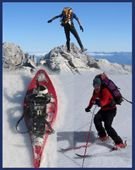
And in Picos Rock & Snow you'll find guided mountain activity holidays such as walking and trekking, snowshoeing and ski touring - plus trip reports as well as general mountaineering information. Catch up with the latest expeditions in the Picos Blog. Independent travellers can find trip packages, support and bag transfer services for self-guided routes.
We hope you enjoy your visit to the Picos de Europa, whether virtual or real!
There are no articles in this category. If subcategories display on this page, they may have articles.
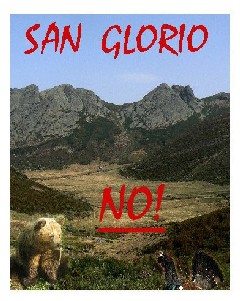 In 2006 I first became aware that what I'd believed to be a ridiculous rumour was, in fact, a very real possibility. Promotors had found a construction company prepared to build another ski resort in the Cantabrian mountains even though the existing three run at a loss. Incensed by the lack of foresight of this project, and the willingness of the local populace to back it, I started an online petition to garner support for opposing the barbaric and arrogant attitude of people that believe that this land is theirs to destroy. Anyone who has seen a ski resort in summer can testify to the ugliness of ski lifts, pylons and pistes without the covering of snow.
In 2006 I first became aware that what I'd believed to be a ridiculous rumour was, in fact, a very real possibility. Promotors had found a construction company prepared to build another ski resort in the Cantabrian mountains even though the existing three run at a loss. Incensed by the lack of foresight of this project, and the willingness of the local populace to back it, I started an online petition to garner support for opposing the barbaric and arrogant attitude of people that believe that this land is theirs to destroy. Anyone who has seen a ski resort in summer can testify to the ugliness of ski lifts, pylons and pistes without the covering of snow.
I've already written a fair amount on the San Glorio ski resort project on the IberiaNature forum.;
"The project for a ski resort in the mountains of Leon, Palencia and Cantabria (San Glorio) is still being stalled by environmental reports and conservation groups. Apart from the destruction of these mountains with all the building, piste-making, huge car parks, etc. and the contamination of soil and rivers with artificial snow-making, the project would mean the end of the Iberian brown bear in these territories by removing a very important corridor of access between the two surviving population pockets. The majority of the local population are under the impression that the project will bring hordes of piste skiers to their region whereas the reality is that these mountains are relatively low compared to the Pyrenees and the Alps, with uncertain snow conditions and high winds."
Here I try to make sense of the sorry saga and keep up to date with the latest developments.
Imagine a poor rural community ekeing out an existence from subsistence farming and living off the land and all that it provides. Now add the tourism boom that Spain enjoyed in the latter half of the twentieth century. What other recourse could the mountains provide to boost the impoverished economy of these people? Winters were harsher then with snow lying much deeper, according to the locals. A ski resort could halt the rural depopulation, provide work and keep the young at home.
Now imagine a land devastated by diggers, disfigured by chairlifts and pylons, rivers drained, wildlife displaced or, at the worst, made extinct, and a human population disillusioned because the promised ski resort turned out to be a white elephant due to adverse weather conditions and climate change.......
While we're at it, we might as well imagine the government of an autonomous community humiliated and voted out of government due to illegal activities (such as the manipulation of laws created to protect the environment) to satisfy their own greed.......No, you're right. That's just taking wishful thinking to the extreme.
If you who don't know these mountains, here's a short film....
The Cantabrian mountains, in Spanish the Cordillera Cantábrica, stretch more or less parallel to the northern coast of Spain running some 500km from the western Pyrenees, through the Basque country, Cantabria, Castille and León, Asturias and into Galicia. They effectively separate Green Spain from the high plains of the Central Meseta and are the reason why the former receives so much rainfall from the prevailing west/north-westerly weather fronts.
They are composed of mostly limestone, conglomerate, shale, quartz, sandstone and granite, giving rise to many interesting rock formations such as this ridge of limestone outcrops that brings to mind the back of a Stegosaurus.
From a distance lumps of conglomerate appear green because of the lichens  growing on the surface.
growing on the surface.
 In places the history of the sedimentary processes and the contortions in the rock are vividly obvious.
In places the history of the sedimentary processes and the contortions in the rock are vividly obvious.
Excluding the Picos de Europa, the highest point in the Cantabrian mountain chain is Peña Prieta, which at 2,539m rises from the central area of these mountains in the province of Cantabria near the border with Castile-León.
See also the San Glorio pages for more on the Cordillera Cantábrica and it's flora and fauna.

Cabrales is the Asturian municipality to the north of the Picos de Europa, famous within Spain for its blue cheese of the same name. Naturally bordered on its north side by the Sierra de Cuera and on its south side by the central and western massifs of the Picos de Europa, its main access road is the AS-114 which, coming from the coast, takes you through the valley from its eastern border at Panes and Peñamallera Baja to its western boundary at Onís. 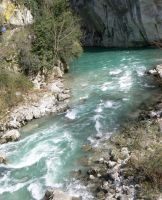
The crystal, blue-green waters of the Cares river accompany the road much of the way. (Locals will tell you it's the most southerly of Europe's salmon and trout fishing rivers, possibly!).
The main towns of the area are Carreña and Arenas ( full names of both suffixed with "de Cabrales"). The former, being the capital, houses the town hall and most municipal services, while the second has a more touristy feel being the gateway to the area's most famous walk, the Cares Gorge. In Arenas you'll find artisan wares, postcards, a post office and trekking clothing. Both towns have bars and restaurants serving fabada (the Asturian version of the French cassoulet), cider and Cabrales cheese, although neither could be described as big. Cabrales' resident population is only around 2,500 people.
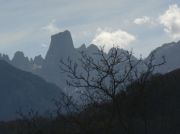
Cabrales can also boast views of one of Spain's most famous mountains, Naranjo de Bulnes. Just outside the village of Poo (de Cabrales), on the main road, there's an ample parking area for the viewpoint. The hamlet of Camarmeña, above Poncebos at the northern end of the Cares Gorge, offers an even closer view. There's now a road up to the hamlet of Camarmeña leaviing the village of Bulnes itself as the only village left in the Picos without road access although the village is now serviced by a steep cog railway built into the mountainside.
The highest village of Cabrales, and the Picos de Europa National Park is Sotres, surrounded by peaks and mountain pasture and accessed by a twisting road with spectacular views.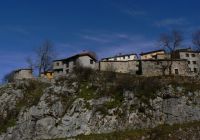
See also Picos Holiday Rentals for accommodation in Cabrales.